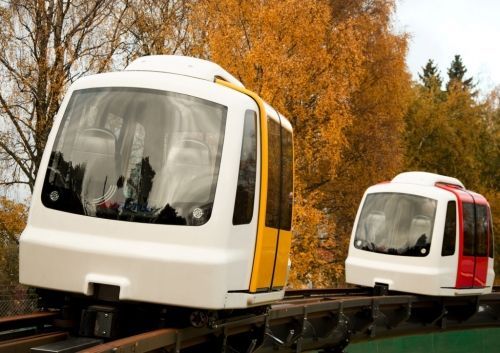Autonomous PRT
Welcome to PRT innovation

What’s the definition of PRT?
Personal Rapid Transit. PRT is a transportation system concept that utilizes a network of small vehicles operating on a grade separate track, or guideway. The vehicles are capable of carrying 4 to 6 passengers.
The concept with PRT is to minimize passengers in a vehicle with a large number of vehicles within the network. This is opposite of a train or streetcar that uses a minimum of vehicles and a maximum number of passengers per train section. This PRT methodology, by increasing car count along the track or guideway; it maximizes the number of passengers being able to travel in that corridor.
A vehicle only stops at its passenger’s designated selection. The automated PRT technology includes a switch that gives each vehicle the ability to stop at or bypass each station. This is a much more suitable form of urban transit system; conducive to modern Western Society that has varying destination points. It means that a vehicle takes the passenger directly to their designated loading and unloading destination and it doesn’t stop where there is no other passenger: loading or unloading. This computer automated network system also operates 24/7 and without a schedule and without a driver.
PRT is a definitive type of transportation network that began in the 1960s. Since its inception, it’s always been autonomous.
With public demand, disruptive technology is what society experience in the communication industry with the phone. Comparing cars to advanced transit technology is like comparing a rotary land-line phone to a smart phone.
In the late 1960s, a magnetic levitation technology transit system was proposed for New York but, the plan was thwarted by the political officials who supported oil and gas industry. As a remnant of that early effort, a small system was implemented at the West Virginia University in Morgantown, WV.
This 50-year-old transit project is referred to as the Morgantown PRT. This was the only PRT system in public use for over 30 years. In 2011, the ULTra company built the airport circulator at the Heathrow Airport in London. This was officially considered the 2nd PRT operational PRT system in the world.
The demise of PRT
Prior to the growth of the Google empire and their dominance of technology, PRT provided a transit solution for the growth of sustainable urban design. PRT’s momentum was growing. Google grew quickly and invested into autonomous vehicle control which fit into their industry monopoly of satellite mapping and global tracking for cell phones.
For a tremendous introduction and explanation to how active the PRT industry was, the greatest PRT and advanced transit industry website is found at this link. The site is still up and the information is still valuable, however, the site hasn’t been maintained since 2013. Now, in 2023, nearly all PRT companies are no longer in existence.
Most of the companies listed on the Washington Faculties site were small companies funded by people who had an idea. Some better than others. The concept of PRT is still valid and practical. Yet, there are very few PRT technology companies with systems that have been implemented.
Along the decline of interest in PRT technology came Hyperloop. PRT’s valuable process of trial and error, learning and gathering information to find the best pieces, was ignored and bypassed by the herds of hyperloop investors. The demise of hyperloop shows that practicality and cost are a vital component to designing a transit technology.
The concept of PRT technology is comparable to a hardwire optic line phone system network as a transportation network. All the parts and circuits are synchronized to be individually operated within a multi-based computerized network.
PRT was introduced as a transportation solution.
Another powerful and catastrophically devastating adversary to transit; is the automobile, and the oil industry.
Transit and land-use
The transit industry has a common dysfunction. The automobile centric land-use design functions to comply to the patterned capability of a car. Automobiles have a general size parameter: weight and passenger carrying capability. A car is able to drive on any road, roads have designated load restrictions, lane rules and various regulations.
An automobile manufacturer has to comply to federal and state manufacturing specifications regarding safety and emissions. Yet the government taxes citizens for where a vehicle operates. The general public is taxed for the automobile manufactures road preparation, rights-of-ways, road maintenance, and the entire automobile manufacture’s usage of infrastructure. The manufactures pay nothing towards where their product is used or what their product does. They have no liability for a car’s operation. The automobile manufacturer has no liability for the rights-of-ways infrastructure or where the car is driven.
Current environmental, economic, and social problems are directly attributed to the arrangement of unsustainable urban growth, based on automobile centric land-use design.
Convenience of the automobile is offset by the intrusive increase to their numbers, exacerbating the problems relating to the unsustainable nature of automobile centric urban growth. The demand for transportation is proportionate to the population. As the population is growing, transportation needs grow at a proportionally greater rate. With the growing population, there is an increased demand for land and mobility. Gasoline price increases at the pump will continue to increase with the depletion of oil supply.
Western Society holds three factors of concern: environmental requirements, economy need, and social demands. All three areas are directly related to mobility.
There are numerous benefits to a New Technology Transit (PRT) system:
· User on-demand and direct-to-destination
· Computer operated, reducing operational expenses and increases efficiency
· Lightweight vehicles lower infrastructure costs and operational expenses
· New Technology Transit systems can be overlaid above with solar panels to provide shade and generate their own power source
· Existing rail rights-of-ways; by using existing rail rights-of-ways, expensive land acquiring capital expenses are eliminated
· Convenient transit increases an area’s economic productivity by reducing commute time and stress of commute travel
· Greatly reduces dangerous toxic air quality levels
· Unaffected by increasing gas prices and dwindling hydrocarbon deposits
· Creates an equitable alternative to the inadequate transportation options
· Worldwide recognition for urban transit solutions
· Lowers stress levels for system passengers
· Higher quality of life where systems are implemented
· More uniform real estate development opportunities
· Quicker commute time
· Quicker commute and travel times
· Reduction of automobile accidents
· No traffic jams for users
· Less traffic congestion
· Creates jobs
Changing transportation
In presenting a new mode of transportation, like PRT, to the public as a competitor to the automobile and oil industry, it must be totally disruptive. A disruptive change happens when practicality of efficiency and sustainable solutions presents itself as more convenient than a car, much faster than a car, less expensive to operate than a car, and safer. Inevitability always finds a way.
What technology is available beyond PRT for advanced transportation? Gravity attracts. And it goes really fast. It’s safer than walking, more reliable than electricity.



